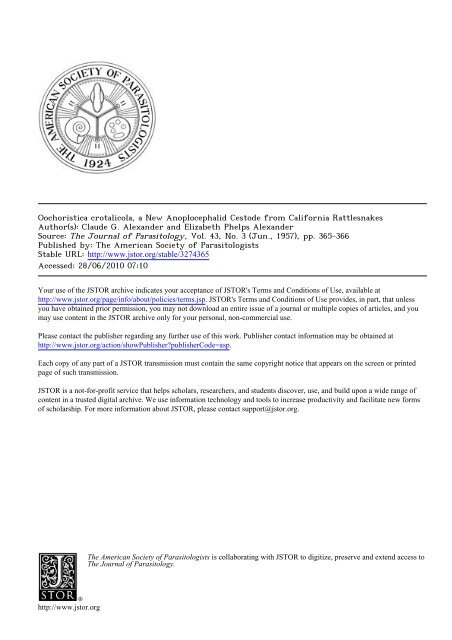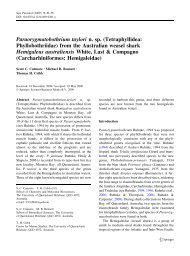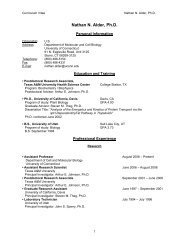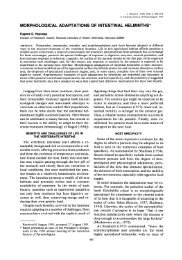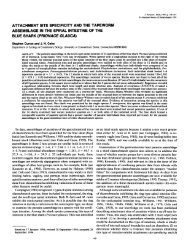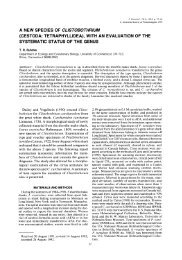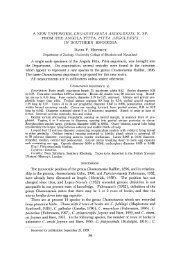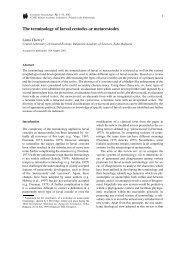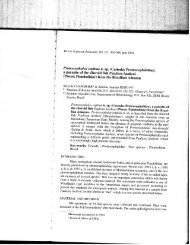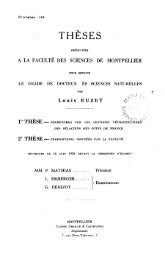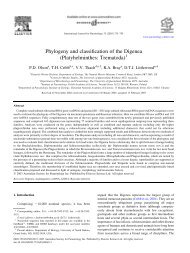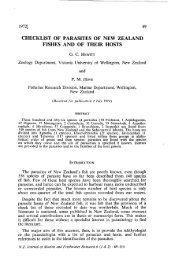Oochoristica crotalicola, a New Anoplocephalid Cestode from ...
Oochoristica crotalicola, a New Anoplocephalid Cestode from ...
Oochoristica crotalicola, a New Anoplocephalid Cestode from ...
Create successful ePaper yourself
Turn your PDF publications into a flip-book with our unique Google optimized e-Paper software.
<strong>Oochoristica</strong> <strong>crotalicola</strong>, a <strong>New</strong> <strong>Anoplocephalid</strong> <strong>Cestode</strong> <strong>from</strong> California RattlesnakesAuthor(s): Claude G. Alexander and Elizabeth Phelps AlexanderSource: The Journal of Parasitology, Vol. 43, No. 3 (Jun., 1957), pp. 365-366Published by: The American Society of ParasitologistsStable URL: http://www.jstor.org/stable/3274365Accessed: 28/06/2010 07:10Your use of the JSTOR archive indicates your acceptance of JSTOR's Terms and Conditions of Use, available athttp://www.jstor.org/page/info/about/policies/terms.jsp. JSTOR's Terms and Conditions of Use provides, in part, that unlessyou have obtained prior permission, you may not download an entire issue of a journal or multiple copies of articles, and youmay use content in the JSTOR archive only for your personal, non-commercial use.Please contact the publisher regarding any further use of this work. Publisher contact information may be obtained athttp://www.jstor.org/action/showPublisher?publisherCode=asp.Each copy of any part of a JSTOR transmission must contain the same copyright notice that appears on the screen or printedpage of such transmission.JSTOR is a not-for-profit service that helps scholars, researchers, and students discover, use, and build upon a wide range ofcontent in a trusted digital archive. We use information technology and tools to increase productivity and facilitate new formsof scholarship. For more information about JSTOR, please contact support@jstor.org.The American Society of Parasitologists is collaborating with JSTOR to digitize, preserve and extend access toThe Journal of Parasitology.http://www.jstor.org
OOCHORISTICA CROTALICOLA, A NEW ANOPLOCEPHALIDCESTODE FROM CALIFORNIA RATTLESNAKESCLAUDE G. ALEXANDER AND ELIZABETH PHELPS ALEXANDERDivision of Natural Science, San Francisco State College andDepartment of Zoology, University of California at Los AngelesFour stained and mounted specimens of a tapeworm belonging to the genus<strong>Oochoristica</strong> Liihe, were found to represent a species heretofore undescribed. Theworms, <strong>from</strong> the small intestine of a Southern Pacific rattlesnake, Crotalus viridishelleri, <strong>from</strong> San Diego County, California, were collected and made available forstudy by Mr. Robert Schick. Additional specimens were obtained <strong>from</strong> a hornedrattlesnake, Crotalus cerastes laterorepens, collected at Soboba Hot Springs, RiversideCounty, California, by Dr. John N. Belkin and Mr. William McDonald. Thelatter specimens consisted only of fragments of several worms, but were sufficientlywell preserved to permit their identification with the species <strong>from</strong> the SouthernPacific rattlesnake.All measurements are given in millimeters, unless otherwise indicated. Drawingswere made with the aid of a camera lucida.<strong>Oochoristica</strong> <strong>crotalicola</strong> n. sp.Diagnosis: <strong>Anoplocephalid</strong>ae; Gravid proglottid 0.94 long by 0.10 wide; mature proglottid 0.81long; neck 0.90-1.00 long. Scolex 0.31-0.35 wide; suckers 0.11-0.16 in diameter. Testes 46-69in number; cirrus sac 0.14-0.17 long by 0.09-0.10 wide. Ovary 0.17-0.24 wide; yolk gland 0.13-0.17 wide; eggs 25-39 microns in diameter; larval hooks 16-22 microns long. Genital poresirregularly alternating, opening in anterior fourth of proglottid margin. Ovary slightly towardporal side. Testes arranged laterally and posteriorly around ovary.Hosts: Crotalus viridis helleri (Type) ; C. cerastes laterorepens.Habitat: Small intestine.Localities: San Diego County, California (Type); Soboba Hot Springs, Riverside County,California.Holotype: U. S. Nat. Mus. Helm. Coll. No. 49094.DESCRIPTIONThe testes occupy most of the posterior half of the mature proglottid (Fig. A), extendinganteriad to the level of the vitelline gland. The junction of vasa efferentia and vas deferens cannotbe ascertained; the vas deferens first becomes visible as it widens considerably immediatelyanterior to the shell gland. It forms several tight coils in midfield, opposite the proximal end ofthe cirrus pouch, and narrows again as it enters the pouch where it forms a few coils insidethe latter structure.The female genital complex is situated in the proglottid center, close behind the level ofthe cirrus pouch. The compact, triangular vitellarium overlies the posterior margin of theovary, between its 2 lobes. A short duct passes anteriorly <strong>from</strong> the yolk gland to an indistinctshell gland, overlying the mid-region of the ovary. The thin-walled vagina pursues a relativelystraight course <strong>from</strong> the genital aperture to the ovary.The egg capsule (Fig. C) is ellipsoidal in shape, with the onchosphere usually eccentricallylocated. Fixed (AFA), unmounted egg capsules measure 58 to 64 microns long by 45 to 51microns wide. In cleared and mounted specimens the onchosphere is characteristically separated<strong>from</strong> its outer membrane by a relatively wide, clear area. In gravid segments the egg capsulesfill most of the proglottid.Received for publication October 1, 1956.365
366THE JOURNAL OF PARASITOLOGYA:. Mature pro lottid; .S ;oo%oo Q ::AA. Mature proglottid; B. Scolx; C. Egg.DISCUSSIONIn having smaller eggs, 0. <strong>crotalicola</strong> differs <strong>from</strong> 0. scelopori Voge and Fox,1950 and 0. anniellae Stunkard and Lynch, 1944, both of which are recorded <strong>from</strong>California lizards. In addition 0. <strong>crotalicola</strong> differs <strong>from</strong> 0. scelopori in having alarger number of testes and a wider cirrus pouch, and <strong>from</strong> 0. anniellae in havinga larger ovary and a more lateral distribution of the testes.0. <strong>crotalicola</strong> resembles 0. gracewileyae, described by Loewen (1940) <strong>from</strong>Crotalus atrox atrox, in the diameter of the suckers, but differs <strong>from</strong> 0. gracezcileyaein having a smaller number of testes, and in the disposition of the testesin the mature proglottid.0. <strong>crotalicola</strong> most closely resembles 0. osheroffi Meggitt, described <strong>from</strong> thebullsnake, Pityophis sayi. However, the scolex of 0. osheroffi is considerablywider than that of 0. <strong>crotalicola</strong>. Study of Meggitt's (1934) figures of 0. osheroffireveals that the ovary is larger, the female genital complex is more centrallylocated, and the testes are more compactly arranged in that species than in 0. <strong>crotalicola</strong>.REFERENCESLOEWEN, S. L. 1940 On some reptilian cestodes of the genus <strong>Oochoristica</strong> (<strong>Anoplocephalid</strong>ae).Trans. Amer. Micr. Soc. 59: 511-518.MEGGITT, F. J. 1934 On some tapeworms <strong>from</strong> the bullsnake (Pityophis sayi) with remarkson the species of the genus <strong>Oochoristica</strong>. J. Parasitol. 20: 182-189.


